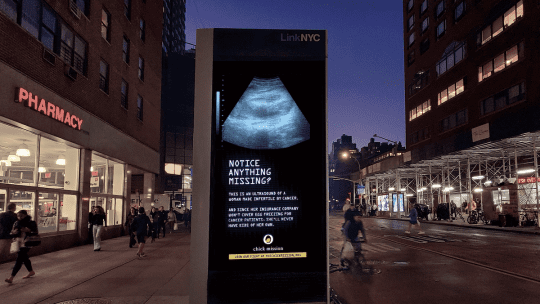
For all the heat PR gets about inane promotions and pedaling wares, at its most fundamental level, communication creates change.
While TV shows and novels may portray PR as glamorous, including star-studded movie premieres and extravagant client dinners (at least in the pre-pandemic times), it’s important to remember that communication also is needed to highlight topics some consider uncomfortable.
This Sunday (May 9), for example, Dini von Mueffling Communications will launch a PSA for The Chick Mission, aimed at raising awareness about the lack of fertility benefits for women with cancer. Screens on ad kiosks around New York City will feature an ultrasound from a woman cancer rendered infertile. Though the image is jarring on Mother’s Day, von Mueffling sees it differently.
“By using the image of an empty womb on Mother’s Day, you’re inherently reminding people that Mother’s Day isn’t happy for everyone...[t]he arresting image...makes people look twice so they understand what the campaign is about.”
What some communicators may consider an uncomfortable topic, is a lifeline for others.
Passion
Evie Smith Hatmaker, founder and CEO of Rebellious PR, prefers to represent disruptive companies and work on issues some consider taboo. She works on campaigns for menstruation awareness, trichotillomania (hair pulling) treatment technology and plus-size activewear, to name a few. For her, the best work coincides with your passion.
“Don't do anything your heart is not in,” she says. “If working with sex toys, cannabis and activism is not your cup of tea, know that about yourself. For me, these are things I care about and would like to see less stigmatization around in the world."
Smith Hatmaker understands this work can require additional prompting of media members, who may be uncomfortable with a topic.
“The thing that surprised me the most with NPD [National Period Day] is that the press was slow to write at first (even though we had individual reporters who thought the story was cool),” she said. “It's like it was too taboo for the newsroom.”
Her firm works with PERIOD, which helps raise awareness of, and eliminate, the lack of access to menstruation products for women.
Audience and Research
Of course, as in any PR campaign, knowing the audience is a critical first step in building a communication strategy.
Culturelle, a probiotic brand, recently debuted an irritable bowel syndrome (IBS) product. IBS affects more than 35 million Americans, but it's rarely discussed as comfortably, as, for example, cancer, heartburn or even erectile dysfunction.
The Thomas Collective worked with Culturelle to launch a campaign during IBS Awareness Month called Take Back Your Days. A significant issue for IBS patients is anxiety and depression, which can cause them to miss out on events due to management of the disease. Cuturelle attacked the problem with a giveaway. It offered consumers $100 to use as they reclaim their newfound symptomless time.
Kimberly Howard-Thomassen, SVP, group director of the Thomas Collective, says the agency looked to people dealing with the disease to create messaging.
The agency builds campaigns based on a three-step process it calls Collective Intelligence. The first step is listening to the audience:
- How do they approach the topic?
- What are recurring themes?
- What advice do they share?
"If there are studies or research available," Howard-Thomassen says, "we spend some time in message boards or in online social groups.”
After that, ask how the brand fits the consumer’s story.
“This not only provides authenticity to the message, but it strengthens the communication by ensuring that how the brand impacts the consumer’s values are front and center.”
And last, the team considers timing.
“What is happening right now that makes this product, message and activation relevant to the consumer?”
For brands like Culturelle, Howard-Thomassen says messaging goals include clarity and comfort.
“The goal of your message should not be lost in the subject matter or uncomfortable feelings that accompany it,” she says. “This is why understanding your audience’s approach to the topic provides so much value; it helps you to navigate squeamish waters.”
Words Matter
Words are at the heart of communication. The form they take and stories they tell can create a profound impact.
For Melissa Zuckerman, SVP, JPA Health, words not only influence an organization's messaging, but they inspire her personal life.
In 2010, Zuckerman lost her father to a prescription opioid addiction. That experience empowered her to open up and share her story. In addition, it prompted Zuckerman to address her depression and anxiety.
“Every story has the potential to help someone else, and sharing my own story can help other families not lose a loved one to a senseless epidemic,” she says.
Zuckerman champions storytelling as one of the most powerful ways PR pros can help people take an uncomfortable action.
“Words matter when trying to inspire others to be comfortable being uncomfortable, especially when it comes to mental health communications and conveying it’s 'normal' to feel your feelings,” she says.
She notes the phrases 'mental health issues' and 'mental health conditions.'
"In theory, these phrases have the same meaning. In reality, we infer 'issues' are negative and a personal problem, while 'conditions' are neutral and suitable to seek support.”
Moreover, words unintentionally can add to stigmatization.
“It’s become common to describe a person who regularly uses drugs or alcohol as a 'substance abuser,'" she says. “This carries a negative connotation...That’s why there has been a medical and public health communications shift to 'substance use disorder,' which more appropriately conveys a diagnosable and treatable health condition.”
As von Mueffling says, “Change comes from communication. These are uncomfortable and complicated topics, but we shouldn't be afraid to discuss them.”
Nicole Schuman is senior editor for PRNEWS. Follow her @buffalogal
